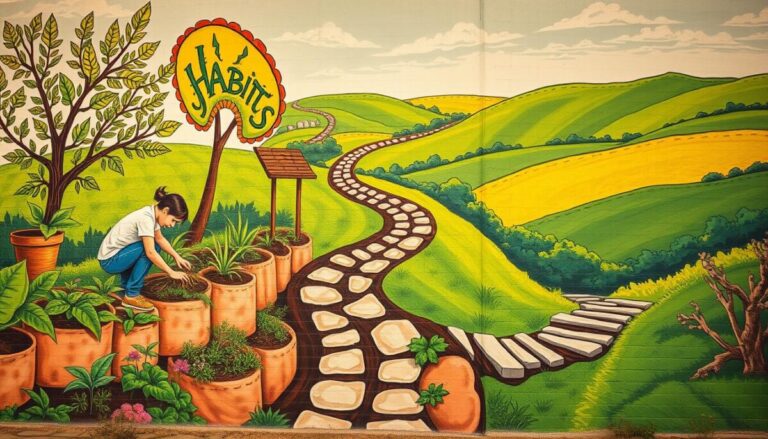
Starting a blog is rewarding, letting you share your thoughts and connect with readers. But, turning it into a success story takes more than just writing. As a beginner, you’ll face milestones like publishing your first article or reaching 1,000 readers.
Setting clear goals and following a step-by-step plan is key to reaching these milestones. In this guide, we’ll cover the essential steps to help you succeed in building your blogging roadmap. Knowing what it takes to succeed will help you overcome blogging challenges.
Key Takeaways
- Understand the importance of setting realistic expectations for your blog.
- Learn how to create a step-by-step plan to achieve your blogging goals.
- Discover the key milestones to track your progress as a beginner blogger.
- Find out how to stay motivated and focused on your blogging journey.
- Gain insights into building a successful blogging roadmap.
The Fundamentals of Successful Blogging

Successful blogging is more than just writing. It’s about making a digital space that connects with your audience. Knowing the key elements for a blog’s success is vital.
Why Blogging Remains Relevant in Today’s Digital Landscape
Blogging is as important today as it was before social media. It lets you share your knowledge, grow a community, and show your brand’s personality.
It’s valued by search engines because of in-depth content creation. This can boost your online presence and attract more visitors to your site.
The Reality of Building a Successful Blog
Creating a successful blog takes hard work, patience, and a desire to learn and change. It’s not a quick way to make money. It’s a long-term plan that can pay off big time.
Most blogs don’t become famous overnight. They grow slowly as the blogger keeps making great content and talks to their readers.
| Key Factors | Description | Impact on Success |
|---|---|---|
| Content Quality | High-quality, engaging, and informative content | High |
| Consistency | Regular posting schedule | Medium |
| Audience Engagement | Interacting with readers through comments and social media | High |
Setting Realistic Expectations for Your Blogging Journey
It’s key to have realistic goals for your blogging journey. Building a loyal audience takes time. It’s okay to see ups and downs in traffic and engagement.
By setting reachable goals and celebrating your wins, you can stay motivated. This helps you keep growing as a blogger.
Defining Your Blogging Milestones

Setting blogging milestones is key to growing your blog. Just like a business, your blog needs targets to reach over time. There are many types of goals, depending on your blogging goals and where you are now.
Short-Term vs. Long-Term Goals
It’s important to know the difference between short-term and long-term goals. Short-term goals are things you can do in a few weeks or months. For example, you might aim to increase your blog’s traffic by a certain percentage. Long-term goals, like becoming a top authority in your niche, take longer, often a year or more.
- Short-term goals might include:
- Boosting your social media following
- Publishing a certain number of posts per week
- Increasing your email subscribers
- Long-term goals could involve:
- Achieving a specific page authority score
- Generating a certain amount of revenue per month
- Collaborating with major brands in your niche
Traffic and Engagement Milestones
Traffic and engagement show how well your blog is doing. Setting milestones for these areas helps you stay on track. For example, you might aim to:
- Increase your monthly page views by 20% within the next 6 months
- Boost your average time on page by 30 seconds
- Grow your social media engagement by 50% within a year
Tracking these metrics helps you understand your audience better. This way, you can adjust your content strategy to better meet their needs.
Monetization Milestones
For many bloggers, making money is a big goal. Your monetization milestones might include:
- Reaching a certain number of monthly visitors before applying for ad networks
- Achieving a specific revenue target per month through affiliate marketing
- Selling a certain number of digital products or courses within a set timeframe
Clear monetization milestones help you focus on making money from your blog.
Content Production Milestones
Regularly posting content is essential for your blog’s growth. Your content production milestones could involve:
- Publishing a certain number of posts per month
- Creating a specific type of content, such as video tutorials or podcasts
- Guest posting on other reputable blogs in your niche
By setting these milestones, you can keep a consistent posting schedule. This keeps your audience engaged and interested in your content.
Setting Up Your Blog for Success

Getting your blog set up right from the start is key to long-term success. A well-organized blog makes for a better user experience. It also helps your blog show up better in search engine results.
Choosing the Right Platform for Your Needs
Picking the right blogging platform is a big decision. You have options like WordPress, Blogger, and Wix. WordPress is top choice because it’s flexible, customizable, and good for SEO. For beginners, start with a hosted solution like Bluehost. It’s easy to set up and works well with WordPress.
If you’re starting a blog, begin with Bluehost. Use my link and start for just $2.95/month.
Essential Pages and Features Every Blog Needs
Some pages are must-haves for a fully functional blog. These include:
- An About page to introduce yourself to your readers
- A Contact page for reader inquiries
- A Privacy Policy page, which is legally required
- A navigation menu to help readers find content easily
Adding these pages and features makes your blog more user-friendly and professional.
Blog Design Best Practices for Beginners
A clean and responsive design is vital for keeping readers. Pick a theme that’s simple yet catches the eye. Make sure your blog looks good on mobile devices, as many readers will visit from their phones.
Mobile Optimization Essentials
With most people using mobile devices, mobile optimization is a must. Make sure your blog’s theme is responsive, fitting different screen sizes. Test your blog on various devices for a smooth experience.
By focusing on these areas, you’ll be on your way to a successful blog that keeps readers coming back.
Creating a Content Strategy That Drives Growth
A good content strategy is key to a successful blog. It helps you connect with your audience. It’s like a map for your content, making sure it hits the mark with your readers.
Finding Your Niche and Developing Your Voice
Finding your niche is the first step to a great content strategy. Your niche sets the focus of your content. It attracts people who are interested in what you talk about.
After finding your niche, it’s time to find your unique voice. Your voice should show who you are and what you believe in. This makes your content stand out and connect with your readers.
Keyword Research Fundamentals for New Bloggers
Keyword research is a must for any content strategy. It’s about finding the words people use to search for content like yours. Using these keywords in your posts can boost your site’s visibility and attract more visitors.
Keyword research can also give you ideas for your blog posts. Tools like Google Keyword Planner, Ahrefs, and SEMrush can help you find the right keywords.
Developing an Effective Content Calendar
A content calendar is a tool for planning your content. It keeps your posts regular, which keeps your readers coming back. It’s important for keeping your blog fresh and engaging.
To make a good content calendar, decide on the types of content you’ll create. Then, plan out your content for the next few months. Think about seasonal topics, holidays, and what’s trending.
High-Performing Content Types for New Blogs
Some content types do better than others, like how-to guides and listicles. Personal stories and tutorials are also great. These types of content are engaging and valuable to your readers.
| Content Type | Description | Benefits |
|---|---|---|
| How-to Guides | Step-by-step instructions on completing a task | Provides value, establishes authority |
| Listicles | Curated lists of items or tips | Easy to consume, shareable |
| Personal Stories | Personal anecdotes or experiences | Creates connection, relatable |
| Tutorials | In-depth instructional content | Educational, engaging |
By using these content types in your calendar, you can grow your blog. It will attract more readers and keep them coming back for more.
Building Your Audience From Zero
Starting from scratch to build an audience takes careful planning. As a blogger, your main goal is to make content that speaks to your readers. This way, they’ll keep coming back for more.
Social Media Promotion Strategies That Work
Social media is a great way to promote your blog and find new readers. Choose the platforms where your audience is most active. For example, if your blog is about fashion, Instagram and Pinterest are good choices.
Share top-notch content, talk to your followers, and use the right hashtags. This will help you get noticed more.
Effective Social Media Strategies:
- Share your blog posts on your social media profiles.
- Engage with your audience by responding to comments and messages.
- Use hashtags strategically to reach a wider audience.
- Collaborate with influencers or other bloggers in your niche.
Email List Building Techniques for Beginners
Having an email list is key to talking directly to your audience. Start by creating a lead magnet that encourages people to subscribe. This could be a free e-book, checklist, or exclusive content.
| Email List Building Techniques | Description |
|---|---|
| Create a Lead Magnet | Offer something of value in exchange for email addresses. |
| Use Opt-in Forms | Place opt-in forms on your blog to capture visitor information. |
| Segment Your List | Organize your subscribers based on their interests or engagement levels. |
Networking with Other Bloggers in Your Niche
Connecting with other bloggers can open doors to new audiences and boost your credibility. Go to blogging conferences, join online groups, and do guest posts to reach more people.
Tips for Effective Networking:
- Be genuine and build meaningful relationships.
- Offer value to others before seeking it for yourself.
- Be consistent in your interactions and follow-ups.
Engaging with Your First Readers Effectively
Talking to your early readers is key to building a loyal community. Reply to comments, ask for feedback, and make content that meets their needs and interests.
Strategies for Engagement:
- Respond to every comment on your blog posts.
- Ask your readers for feedback and suggestions.
- Create content based on the questions or topics your readers are interested in.
Tracking and Achieving Key Blogging Milestones
Success in blogging comes from tracking and celebrating your achievements. As a blogger, knowing your progress and making smart decisions is key. This helps you grow and get better.
Essential Analytics Every Blogger Should Monitor
To track your blogging milestones well, you need to watch the right analytics. Google Analytics is a great tool that shows you your blog’s traffic and audience behavior. It also helps you see how your content is doing.
Google Search Console is also important for checking your SEO and finding ways to get better.
Some key metrics to watch include:
- Page views and unique visitors
- Bounce rate and average session duration
- Traffic sources and referral sites
- Content engagement metrics, such as comments and social shares
Setting Up Goal Tracking in Google Analytics
Goal tracking in Google Analytics lets you measure important actions on your blog. This could be newsletter sign-ups, contact form submissions, or e-commerce sales. By tracking goals, you can see how your content is helping you achieve your goals.
To start goal tracking, follow these steps:
- Log in to your Google Analytics account and go to the Admin section
- Select the view you want to track goals for
- Click on “Goals” and then “New Goal”
- Choose a goal template or create a custom goal
- Configure your goal details and settings
Celebrating and Learning From Each Milestone
Celebrating your blogging milestones is key for staying motivated and happy. Whether it’s reaching a page view goal, getting a certain ranking, or getting comments, it’s important to celebrate.
“Success is not final, failure is not fatal: It is the courage to continue that counts.” –
When you hit a milestone, take time to think about what worked and what didn’t. Look at your data to see what helped you succeed.
Adjusting Your Strategy Based on Performance Data
As you track your milestones, it’s important to change your strategy based on your data. Look at your analytics to find areas to improve and opportunities to grow.
If you see that some content does better than others, focus on those types. If you find technical issues or user experience problems, use your data to make improvements.
By always tracking your milestones, celebrating your wins, and adjusting your strategy, you’ll be on your way to success in blogging.
Monetization Strategies for New Bloggers
With a solid content foundation, you’re ready to explore various monetization strategies for your blog. Making money blogging isn’t just about being a great writer. It’s about having the right strategy and being authentic with your audience.
When to Start Monetizing Your Blog
Timing is key when monetizing your blog. Start when you have a sizable and engaged audience. This usually happens after publishing a lot of quality content and seeing consistent traffic.
It’s important to balance giving value to your readers and introducing monetization. Too many ads or affiliate links too early can scare off readers. Waiting too long might mean missing out on revenue.
Affiliate Marketing Step-by-Step Guide
Affiliate marketing is a popular way to monetize a blog. It involves promoting products or services and earning a commission on sales through your link.
- Choose affiliate programs that fit your blog’s niche and audience interests.
- Create content that naturally includes your affiliate links, like product reviews or tutorials.
- Always disclose your affiliation with the product/service provider to keep things transparent with your audience.
Display Advertising Options for Growing Blogs
Display advertising is another effective strategy, involving ads on your blog. You can work directly with advertisers or use ad networks like Google AdSense.
To make more money from display advertising, focus on creating high-quality, engaging content. The more relevant and engaging your content, the more attractive your blog is to advertisers.
Creating and Selling Digital Products
Creating and selling digital products is a great way to monetize your blog. Digital products can be e-books, online courses, software, or membership sites.
To succeed, identify what your audience needs and create products that solve their problems or add value. Promote your digital products through your blog and social media, using your existing audience to drive sales.
By diversifying your monetization strategies and focusing on providing value, you can make your blog a sustainable source of income.
Overcoming Common Blogging Challenges
It’s key to beat common blogging hurdles to keep moving forward and hit your goals. Bloggers often face obstacles that slow them down. But, with smart strategies, you can get past these and grow your audience.
Dealing with Writer’s Block and Content Fatigue
Many bloggers hit writer’s block and feel tired of creating content. Try new things like changing where you write, taking breaks, and finding new ideas. Try different content types, like videos or podcasts, to spark your creativity.
Also, use a content calendar to stay on track and keep posting regularly. Even when you’re out of ideas, revisit and update old posts to attract new readers.
Maintaining Consistency in Your Publishing Schedule
Keeping your audience interested means posting regularly. Plan your posts ahead with a content calendar. This helps you see what’s coming and adjust as needed.
Set achievable goals for how often you post. Whether it’s every week, two weeks, or a month, sticking to it builds trust. Batch your writing to save time and ease the pressure.
Handling Negative Feedback and Criticism
Not everyone will like what you write, and that’s fine. When faced with negative comments, stay calm and don’t take it personally. Use criticism to improve and grow, making your content better for your readers.
Learn to handle criticism well. Good criticism can help you. Talk to your critics professionally, and use their feedback to better your blog. Not all comments are helpful, so learn to tell the difference.
Recovering from Algorithm Changes and Traffic Drops
Changes in algorithms can hurt your blog’s visitors. To bounce back, keep up with SEO trends and adjust your approach. Diversifying where your visitors come from can also help.
If your traffic falls, check your content and SEO for problems. Refreshing old posts, making your site easier to use, and improving your SEO can help bring back visitors.
Conclusion
Starting your blogging journey? Setting realistic goals is key to success. Knowing the basics of blogging and setting milestones helps you make a roadmap. This roadmap guides you to your blogging goals.
To reach your milestones, you need to set up your blog for success. You also need a content strategy that grows your blog. Building an audience from scratch is another important step.
Tracking your progress and facing common challenges are also vital. These steps help you succeed in blogging.
By following this guide, you’ll build a strong foundation for your blog. Stay dedicated to your blogging journey. You’ll reach your important milestones.
Understanding what it takes to succeed in blogging gives you confidence. You can create a successful online presence that connects with your audience.
FAQ
What are the most important blogging milestones for beginners?
How long does it take to achieve blogging milestones?
What is the best way to set realistic expectations for my blog?
How do I choose the right blogging platform for my needs?
What are some effective strategies for building an audience from scratch?
How do I overcome writer’s block and maintain consistency in my publishing schedule?
When is the right time to start monetizing my blog?
How do I track and achieve key blogging milestones?
What are some common challenges bloggers face, and how can I overcome them?
Frequently Asked Questions
- Q: What are the most important blogging milestones for beginners?
- A: Beginners should aim for certain blog post numbers, website traffic, and email list sizes. These milestones show your progress and keep you motivated.
- Q: How do I track and achieve key blogging milestones?
- A: Use analytics tools like Google Analytics to track your progress. Monitor traffic, engagement, and email list growth. Celebrate your successes and adjust your strategy as needed.
- Q: What are some common challenges bloggers face, and how can I overcome them?
- A: Common challenges include writer's block, maintaining consistency, and handling negative feedback. Stay focused, adapt your strategy, and engage with your audience to overcome these challenges.
Share :
You Might Also Like







